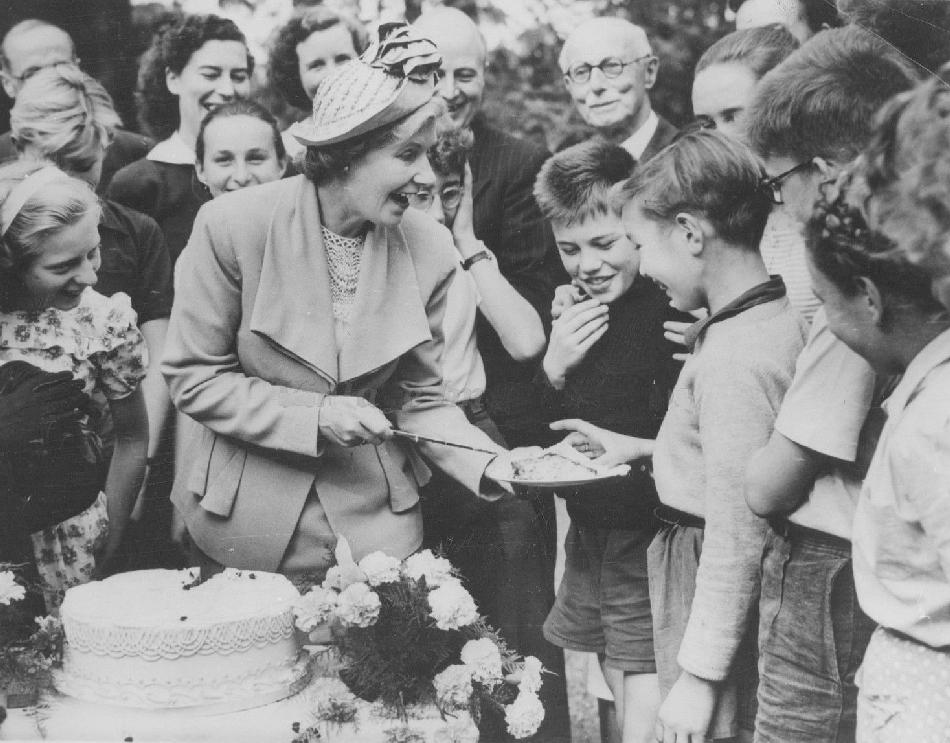British Prime Ministers: Clement Atlee (1945-51)

Figure 1.--Here we see Mrs. Attlee with some French children in Farnham, a town in Surrey. The press caption read, "How Big? Mrs. Clement Attlee, wife of thr Prime Minister, hands out the cake at a party given for 25 French children breing entertained by the International Help for Children Foundation. Purpose of the organization is to bring groups of foreign children adversely affected by World War II to Britain for a holiday." The French kids here may have been the children of French POWs held by the Germans. The photograph was taken September 11, 1949.
|
|
Clement Attlee was Britain's second Labour prime minister and best known for the establishment of the welfare system in Britain and presiding over the first step in disolving the British Empire--independence for India. He was born in Putne, London (1883). He grew up in a prosperous family and had all the advantages. His farther was a successful London solicitor. Coming from a prosperous family, he was educated at a public (elite privte boarding) school, in his case Haileybury College. The school traced its roots to East India Company and this had a strong imperial tradition. He then studied at Oxford. He planned for a legal career, but developed a passion for social work soon after beginning his law casreer which he abandoned (1909). He joined the Fabian Society (1907) and the Independent Labour Party (1908). He took up residence in the London slums. He served in World War I (Gallipoli, Iraq, and France). He was a profoundly conservastive individual, except for his politics and economics. He had no real job experience or economics training, but firmly believed in socialist economics -- primarily for ethical reasons. Attlee entered London East End (a poor section of the city) politics after World War I and achieved some success. He became mayor of the borough of Stepney (1919) and then was elected to Parliament from Limehouse (1922). He worked his way up to the Labour leadership and fter reputiting MacDonald becme the Labour Leader (1935). By this time situation in Europe was beconing ominous (1935). Labour pacifism and resistance to rearmament and War was a factor in Hitler's rise. As Labour leader he played a key role in shifting Labour from pacifism to armed resistance to Fascism. He stubbornly refused, however, to enter into a coalition Government with Prime Minister Chamberlain. This led to Churchill becoming prime minister (1940). He became the leading figire in the World War II coalition war cabinet other than Churchill. He became lord president of the council while retaining the deputy prime ministership. Only Attlee and Churchill served continuously in the war cabinet throughout the War. After V-E Day (May 1945), Attlee led Labour out of the coalition and achieved a massive parliamentary majority in the general election (July 1945). Labour won a commanding 393 seats in the House of Commons. He replaced Churchill at the Potsdam Conference. The British people wanted and end to war-time austerity and change. They got massive change in the form of a wealfare state and nationalization of basic industries. The welfare state did address basic inequities. They did not get and end to austerity. What Attlee and the British electorate did not undertand yet was that socialism such as nationalizing basic industries just does not work. Thus Labour's economic policies caused Britin to decline from the wealthiest country in Europe to a position behind German, France, and other countries. There were presistent ballance of payments problems. Economic aid from America was needed. The pound weakened. As a result of economic failure, Attlee was unable to end World War II rationing which incredably continued into the 1950s. Despite considerable sympathy for Stalin and the Communists within his Labour Party, Attlee continued the close relationship with the United States in the developing Cold War and a sizeable military budget. Attlee and Labour held office for more than 6 years and as a result of creating the British welfare state was in terms of domestic policy probably the most consequential primeminister of the 20th century. He created a basic problem, however, that all subsequent prime ministers have had to contend with, how to pay for the welfare system.
Navigate the Children in History Website:
[Return to the Main British primeminister page]
[Return to the Main national leadership page]
[About Us]
[Introduction]
[Biographies]
[Chronology]
[Climatology]
[Clothing]
[Disease and Health]
[Economics]
[Freedom]
[Geography]
[History]
[Human Nature]
[Ideology]
[Law]
[Nationalism]
[Presidents]
[Religion]
[Royalty]
[Science]
[Social Class]
[Bibliographies]
[Contributions]
[FAQs]
[Glossaries]
[Images]
[Links]
[Registration]
[Tools]
[Children in History Home]
